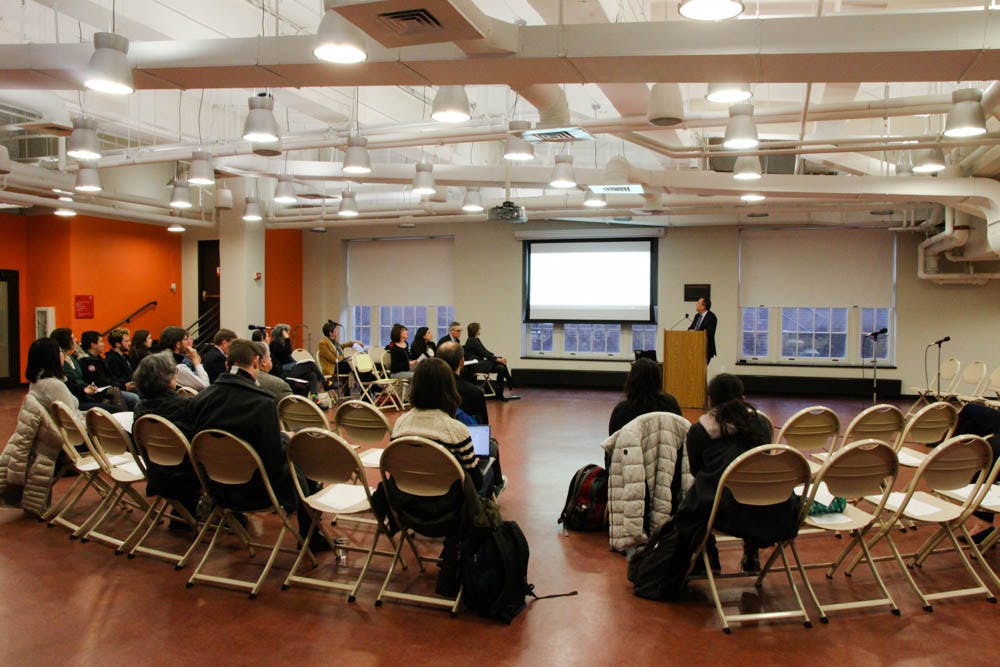A student employment working group recommended several changes to University student employment practices at the Brown University Community Council’s first meeting of the semester yesterday. The group suggested that the University increase the number of community service jobs available through federal work-study, change criteria for work-study hiring and further publicize employment opportunities, among other suggestions, said Dean of Financial Aid Jim Tilton on behalf of the group.
The working group was made up of two undergraduates, faculty members, staff members, administrators and others, and it based recommendations on the results of a survey of 18 peer institutions and an internal data-based review, Tilton said.
First, the group recommended increasing the number of jobs in community service funded by federal work-study. Currently 7 percent of the money allocated to federal work-study funds community service jobs, and the group advised that number increase to 10 percent. The federal work-study program requires that participating universities allocate a minimum of 7 percent of their funding for this purpose.
“We found that most institutions did more than the 7 percent, which gets our students the opportunity to work off-campus, or for NGOs and other kinds of things,” Tilton said.
The group also suggested that university scholarships, and not federal work-study, be used as a criteria for preferential treatment in hiring. Normally, receiving a work-study is a preferred characteristic for applicants, but because the University often gives large scholarships to low-income students without the added work-study, those students can lose out on the chance to receive the benefit in University hiring processes. The group’s recommendation moves to change that practice. Yale currently employs this system, Tilton said.
To increase the accessibility of employment, the group also advised increasing outreach on campus. “One of the things the committee agreed on is that we really needed a much more comprehensive employment awareness program on campus, starting (with) their first year and doing a much better job about notifying them about the kinds of jobs available,” Tilton said.
In comments after Tilton’s presentation, Provost Richard Locke P’18 proposed considering the quality of work experiences in future reviews of student employment.“It would be interesting if we could get an audit or some sort of sense of the quality of the jobs,” Locke said.
Tilton reported that 3,147 students worked in 4,882 positions on campus during the 2016-17 academic year. Dining Services was the most common employer, offering 577 positions.
Students on financial aid received wages comparable to those of students not on aid, although aided students worked on average between 1.5 to 2.25 hours more per week, Tilton said.
The Office of Financial Aid recommends that students work at most 10 to 12 hours per week to earn the work-study component of their aid package. Although most students worked fewer than 10 hours per week on average, 79 students worked more than 280 hours over the 28 week 2016-17 academic year.
“In combination with Campus Life, the Dean of the College (and) financial aid, (we want to) get an idea of why they might be working” that often, Tilton said. “We want to make sure that’s not something that students are being forced to do but something students are choosing to do.”
At the end of the meeting, President Christina Paxson P’19 also offered brief updates on the work of energy and environment groups established in September.
Two groups have “been focusing over the fall in a really productive way on how we can change our procurement of electricity in order to reduce our carbon footprint,” Paxson said, adding that these groups will present a plan by May. The University is currently working to reduce emissions to 58 percent of 2007 levels by 2020.
“It looks like with some facilities improvements that we’re making, we will get there. We are very, very close to there, and what we need to do now is say, … ‘how quickly do we think we can get to a net zero campus?’” Paxson said.
The next meeting of the BUCC will be held on Tuesday, March 20.





